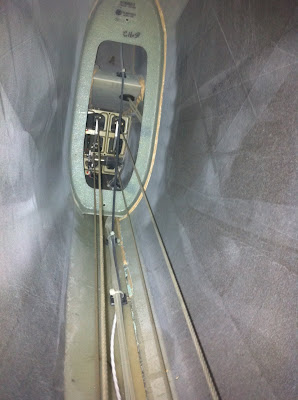This leads me to my flight yesterday. I fly a fair bit with 210 hours last year and I averaged 19 hours a month, which is pretty good. I flew a lot of major cross country trips from Kansas City to Minnesota, Wisconsin, New York, Georgia, Tennessee, Kentucky, Alabama, and Texas. On almost every long trip I took, I logged some IMC time and had to shoot many instrument approaches. However since last November I haven't been flying nearly as much due to the bad weather we were having here in the midwest (lots of ice and very cold), as well as an electrical issue that had my plane AOG for a while and then I had to conduct my annual Inspection, which also took a few weeks. That all being said, my instrument currency was getting close to "expiring" and well my proficiency kind of sucked!
After breakfast we decided to fly to the Topeka VOR (TOP) and execute some holds and then execute the VOR RW22 approach back into KTOP. The winds were 130@12 and RW13 was the preferred RW, but I asked for RW4 since it would take us directly to the VOR and I could also practice a cross wind take-off. We departed with no issues and I set up for the VOR hold at TOP. This is where the fun began (remember I said the winds were 42 knots at 2500') as I attempted to cross the VOR at 2800' to set up for a tear drop entry. The winds were so strong that I got blown to the west of the VOR and had to compensate more east to get into the hold. Because of this massive deviation, we decided to make a right turn (east) and basically do a direct entry and then head straight in for the VOR because we were so badly off course. We then crossed the VOR and made the easterly turn and entered the hold. We made two race tracks around the hold using massive corrections to compensate for the winds and then shot the VOR RW22 approach with a circle to land RW4. My next issue happened that lack of proficiency caused, where my Navigation radio (G430 GPS) decided to stay suspended in the hold, while I began to execute the decent. So fighting with the wind, I had to reset the approach in the radio while executing the approach. This was a real pain in the butt, but I had the VOR tuned in and could fly the necessary heading, but if it would have been IMC, I most likely would have gone missed and then re-executed the approach. I descended to minimums and then began a close left downwind RW22 over the field and then brought the plane around for a low approach over RW4. This was a really fun approach because of all the complexity of changing headings at the VOR upon exit of the hold and then adding the close circle to land and low approach.
Next we departed the pattern, climbing to 5500' and direct to East Kansas City (3GV). I called up Kansas City Approach and they cleared me through the Class B and gave me vectors to the GPS RW9. After being cleared I executed the GPS RW9 non-precision approach and landed with no issues to get some fuel. This was my first time into 3GV on a full stop landing and I was a bit shocked at how poor the runways were with all the bumps and humps. This place has prop strike written all over it! We fueled up and decided to execute a soft field take-off, so as to help reduce any prop strike incidents and departed back to KMKC. While we had been flying we were watching a small storm cell moving towards Kansas City and it now appeared to be just to the south west of the city and moving in fast. Shortly after landing at KMKC it began to rain and then actually snowed!! It was a good thing that we finished when we did or the weather could have been really ugly.
So after executing four approaches, holds and tracking navigational aids and I am current for another "six months", since I had executed two approaches in December. Needless to say, I am NOT proficient and need to get back up and do some more practice. I am feeling a bit rusty - still safe, but rusty. With the summer weather approaching, hopefully I will get some more flying time in soon. It was a great day to fly and the winds made it challenging, but once again this is why I love flying so much, because you have to stay proficient and fly often to retain the skills that you have learned. Staying proficient is EXTREMELY important to me, since I often fly with my family on board and I owe it to them to keep them safe at all times.














